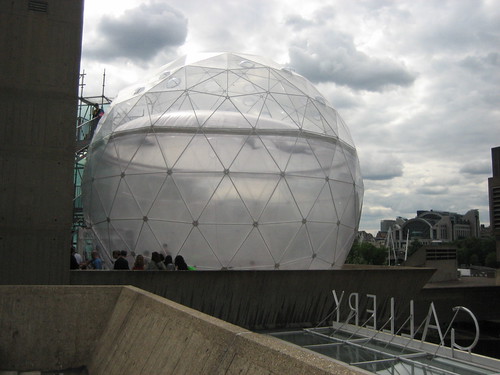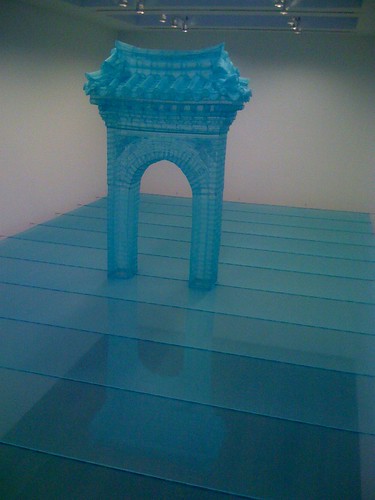I want to make some comments on the relationship between participatory art and aesthetic art. First I will describe three "fishbowl" artworks. Last year was a big year for fishbowl art. I am thinking of three installations in particular: Do-Ho Suh's Reflection, Leandro Erlich's Swimming Pool and Tomas Saraceno's Observatory: Air-Port-City.
These three works share many qualities. They use surprise and humor (haha, look at the funny creatures in there). They rely on industrial materials, transparency and translucency to achieve their effect. All three adopt a split-level structure, dividing the audience into two classes on two different levels, where visitors on a higher level can see/be seen by the people on the lower level, separated by a layer of material.
By positioning the audience behind a transparent material layer, these works create an "inside", a site of containment and display, that references spectatorship and the beholder. Through drawing attention to the environment we live in and its constructed nature, the works of course reference the virtual. They also engage the audience in looking at each other, and in this sense they are all social works, the audience participates in social forms of play.
Observatory

Tomas Saraceno
Observatory, Air-Port-City (2008)
Photographed at Hayward Gallery in 2008
Observatory utilizes materials in a direct and utilitarian manner to create a fairground ride, a high tech Bouncy Castle on the top of a museum. Members of the public are allowed to enter the upper or lower portion of a large spherical structure. The upper floor is made from translucent plastic. People below can see can look up and see the upper deck people floating above them.
The message here is - bounce around, have fun, enjoy!
Observatory is similar to Carsten Holler's slides at the Turbine Hall of the Tate modern: art as a thrill ride, artist as an enabler of an experience. Much of the success of these types of work depends on operational pragmatics. For example, both Holler's slides and Saraceno's Observatory suffered from long lines and strict health and safety restrictions. As a value judgement, I can say I enjoyed the ride down the slides at the Tate far more than the Observatory, mainly because the guards at the Observatory repeatedly told us not to bounce. All that waiting and the payoff was anticlimactic.
As art, Observatory is closest to a pure relational model. The focus is on the audience and participation. The dome is a big industrial object that is impressive and quite striking to look at. But the aesthetic forms at play are fairly established, conservative rather than complex. There is little to shock or frustrate, little that is unexpected. Observatory reaffirms the spectacle and arts' role in it, rather than offering a critique.
Swimming Pool

Leandro Erlich
Swimming Pool (2004)
Photographed at P.S. 1 in 2008
An encounter with Swimming Pool happens in three stages. First, you see what looks like a swimming pool, your believe it is a real indoor pool. Second, you see people standing below, it only takes a moment or two to understand that it is a fake swimming pool, a trick. Third, you decide to believe in the illusion anyway, to treat it as real even though you know how it works, so you can enjoy the oddity of seeing people standing at the bottom of the pool.
In Swimming Pool, Erlich uses a transparent acrylic sheet and a thin layer of water to create the illusion of a small indoor swimming pool. Swimming Pool has a strong social element, since the piece works best when there are some people below and some above. The audience activate the work.
However, the piece is not purely social. At its core it is illusionistic. Like a magic trick, the artist takes on the role of the magician. The suspension of disbelief that happens in Swimming Pool is similar to our experience with realist paintings - you know that what you are looking at is not "real" but decide to believe it in any case. Swimming Pool is therefore activating aesthetical concerns. Swimming Pool reclaims the role of the artist as an individual capable of facilitating transformations. The scale of the model is important. Swimming pool is a modest pool, almost intimate, the kind you could imagine having in a small private residence. It has a hand-made feel to it, there is some evidence of the artist's hand. You can imagine the artist making the model in his studio. All of these factors temper the social element in Swimming Pool.
Reflection

Do-Ho Suh
Reflection (2004)
Photographed at Lehmenn Maupin Gallery in 2008
For Reflection, Do Ho Suh created a model of an archway out of silk, then made a duplicate of the model, and positioned the two models stacked vertically, so one appears to be the reflection of the other. Viewers can either enter the lower chamber, and look up through the "water" (a thin layer of silk), or enter a balcony above and look down into the water.
When I first encountered Reflection I was on my own in the space, and the archway evoked a dreamy and slightly eerie impression. Reflection has sufficient autonomy as a sculptural object that it does not need multiple people present in the space to activate it. It functions well as a sculpture in its own right. In this respect it differs from Observatory and Swimming Pool, which both function best with a group of beholders.
During my visit, some people entered the lower space while I was upstairs. What struck me was how the people became entwined in the exhibit - I found myself imagining them as carp in a pond. Rather than the surrealist "oh there are people beneath the water" sight-gag of Swimming Pool, or the art-as-play of Observatory, in Reflection I found myself caught in representational and imaginary modes of thinking. In this respect, Reflection was, of the three pieces, the least participatory, the most reliant on aesthetic values.
Art and the social turn
I first mentioned the essay "The Social Turn" by Claire Bishop in my post on the Deller show at the New Museum. Taking up that essay again, Bishop at one point remarks on how we must reevaluate the terminology we use to evaluate socially engaged art:
The development of a new artistic terminology by which to discuss and analyze socially engaged practices is now an urgent task - and one that is not assisted by the present-day standoff between the nonbelievers (who reject socially engaged work as marginal, misguided and lacking artistic interest of any kind) and the believers (who reject all aesthetic questions as synonymous with the market and cultural hierarchy). If the former risk condemning us to a world of market-driven painting and sculpture, the latter self-marginalize to the point of artistic and political disempowerment.
Bishop refers us to a set of binary oppositions identified by Gillian Rose which capture the two sides of this standoff:
- active and passive viewer
- egotistical versus collaborative artist
- privileged versus needy community
- aesthetic complexity versus simple expression
- cold autonomy versus convivial community
However, as Bishop is quick to note, these kinds of binary oppositions are too reductive. A productive rapprochement must take place.
I think this is beginning to happen. The work of Do-Ho Suh, Leandro Erlich and Tomas Saraceno shows there are many shades to participation, a spectrum of midway points between pure aesthetics and pure sociality. Artists in the future will seek new positions, awkward balancing points, which lie between these two poles.



No comments:
Post a Comment